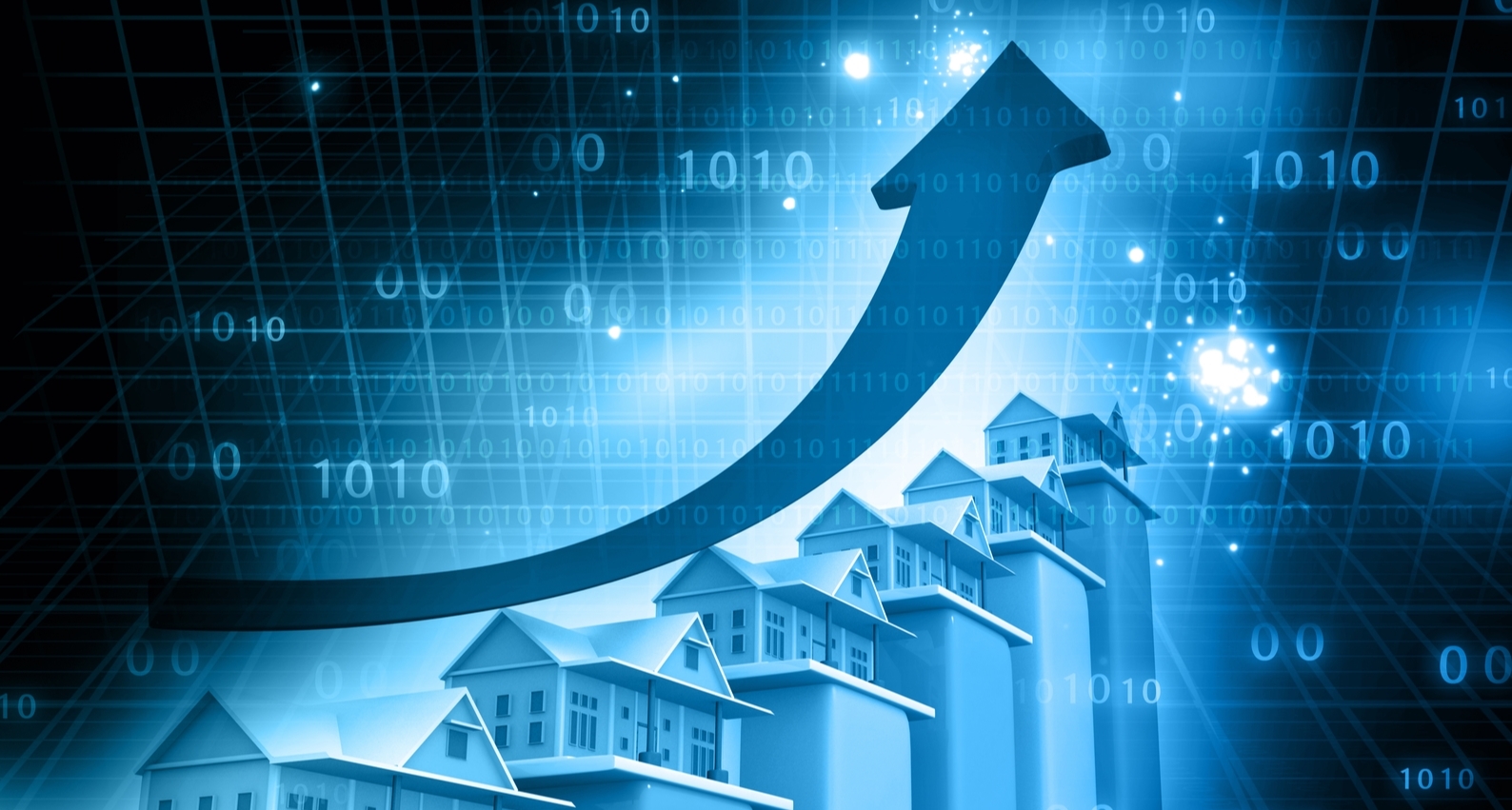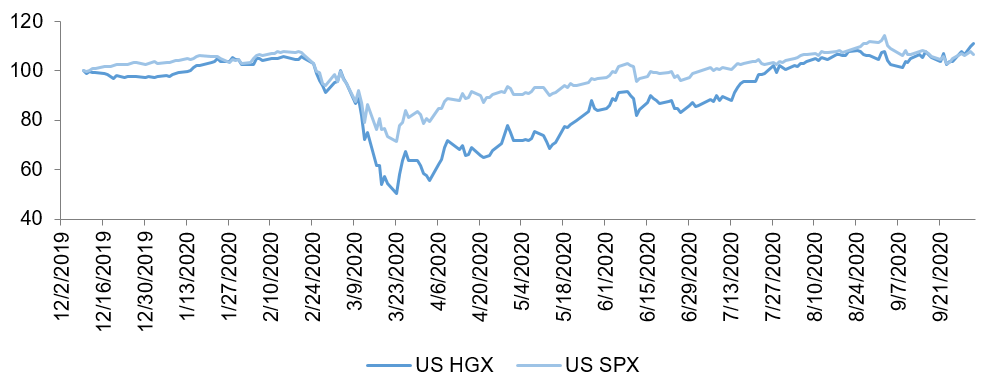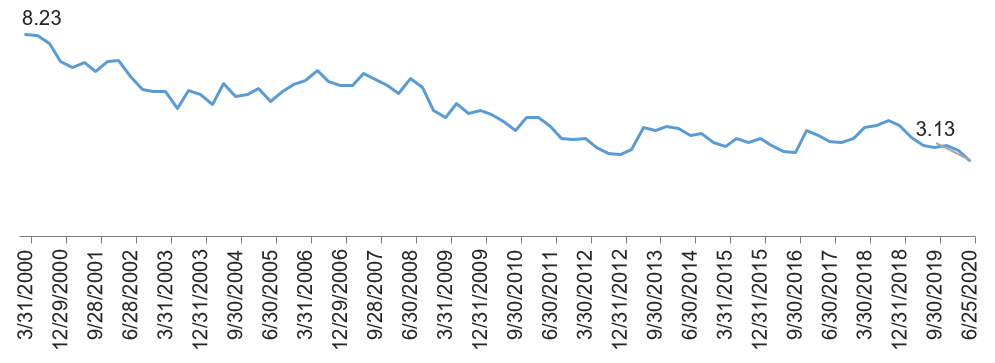US Housing Market: Will Robust Demand Continue?
Published on 09 Oct, 2020

While the US economy sank a record 31.7% in 2Q20, the country’s housing market has shown tremendous resilience. Demand for housing rose across segments in the sector, but bigger homes in suburban or rural areas have attracted more buyers and generated interest. Is this a short-term effect of the pandemic or a long-term trend?
The US housing market has been quite immune to the effects of the pandemic since dropping to its lowest point in March 2020. The PHLX housing index indicates a strong V-shaped recovery led by increased demand for cleaner and safer living/housing. The main drivers are multi-decade low mortgage rates, de-urbanization, strong demographics and demand-supply imbalance.
PHLX Housing Sector Index vs S&P 500 Index

Source: Bloomberg
Multi-decade low mortgage rates
The 30-year fixed rate mortgage average in the US has declined steadily for the past four decades. However, over the last 10 years, the inclination toward saving has increased following the financial crisis in 2008-09 triggered by the sub-prime mortgage crisis. The COVID-19 pandemic forced many people, particularly the millennials whose savings have risen following the Great Recession to benefit from the sub-3% mortgage rates. According to a recent 2020 Homebuyer Insights report by Bank of America, approximately 89% buyers plan to purchase their first home, while 77% are ready with the down payment (locked in currently as savings). Lower mortgage rates amid the pandemic have made it highly affordable for home buyers to purchase a high value property or a bigger house at the same monthly mortgage payment. As per an August 2020 survey conducted by The Simple Dollar, 68% of Americans (who think 2020 is an ideal time to buy a home) cited low mortgage interest rates for buying a home or a property in 2020.
30-Year Fixed Mortgage Rate

Source: Bloomberg
De-urbanization or de-densification
Health and wellness have become the top priority amid the ongoing pandemic. However, maintaining social distancing becomes difficult when people live near to each other. Apartments in metro cities are usually densely packed with shared halls and stairways, and limited open space and parking areas. Furthermore, while approximately 84% of the population in the US lives in urban areas, the urban land area constitutes just 3% of the total land area. This is driving people to suburban or rural areas with more open spaces. The year-to-date decline in home sales in some densely populated metros reflects the trend. For example, home close sales fell 7.9%, 18.2% and 8.9% year-to-date (through July) in the Chicago, New York and San Francisco metropolitan areas, respectively. Another fact that has contributed to the rising demand for houses in suburban regions is the need to stay at home. Currently, around 40% of the US’s population is working from home. A recent survey by KPMG shows that this is expected to lead about 68% of large companies to downsize their office space. Therefore, having accommodation closer to office is no longer a necessity, implying a wider choice to go with personal preference in terms of area of residence. According to the National Association of Realtors (NAR), de-urbanization could be a permanent trend even after the much-awaited vaccine is developed. A July 2020 survey by Redfin of homebuyers before the pandemic and now shows that the number of people searching for a home in suburban and rural areas has risen by 13%.
Pre-Pandemic vs Existing Home Demand
Source: Redfin as cited in World Property Journal
Demand-supply imbalance
Lower mortgage rates and pent-up demand due to de-urbanization have boosted the overall demand for homes. With resale inventory dropping to record low levels, demand for new homes is growing. According to a report by the NAR, in August 2020, existing home sales touched a 14-year high, a record level last seen in December 2006. Existing homes sales that constitute a sizable portion of home sales in the US rose 10.5% year-on-year over this period. In fact, single-family home sales grew 9.8% and 11% year-on-year in July and August 2020, respectively. Increased demand for existing homes has sent inventory levels to multi-year lows. Home building companies have seen a surge in demand for new homes in recent months. Virtual buying is picking up, with buyers adopting either a hybrid or end-to-end virtual buying approach. Rising demand for digital tour or purchase, especially from millennials and Gen Z customers, is driving homebuilders to focus on providing seamless virtual solutions that include search, house tour, finance and purchase, eliminating the need to step out.
US Existing Home Sales Inventory (millions)
Source: Bloomberg
Favorable demographics
Demand prospects for new homes across buyer segments appear strong. Going by Google search statistics, searches for first-time home buying have increased significantly in the past few months compared to the last five years. This indicates that the surge in demand is largely due to millennials and Gen Z. According to a September 2020 survey conducted by Morning Consulting on 4,000 adults on how COVID-19 has affected home ownership, 28% millennials were found more interested in buying a home, followed by Gen Z at 20%. The demand from Gen Z was particularly from college-educated professionals with jobs that had long-term employment visibility. On the other hand, millennials who have delayed homeownership and are living in rental homes are going for purchasing a house supported by several years of savings. A strong resale market has also provided exit opportunities for second-up buyers and baby boomers who are looking to invest in bigger and more luxurious homes.
Keyword: First-time home buyer (US)
Source: Google Trends
Despite the secular long-term trend favoring demand, homebuilders are exercising caution due to the weak macroeconomic environment amid the pandemic and its effect on mortgage delinquencies. The mortgage delinquency rate has spiked in the last two quarters. Latest available data pegs it at 8.22% for the quarter ended June 2020, a level last seen during the fag end of the Great Recession. Unemployment shot past 13% during the June quarter following the economic shutdown triggered by the pandemic that led to job-cuts. However, the rate has been declining gradually as sectors and businesses open up slowly across the US. It was reported at 7.9% in September 2020.
Mortgage Delinquency Rate
Source: Bloomberg
Despite the weak economic environment, a few macro indicators for the housing sector are looking better compared to those during the Great Recession of 2008.
Macro factors | Recession (Dec 07-June 09)* | Covid-19 (Mar 20-Sept 20)* |
|---|---|---|
Consumer sentiment | 64.2 | 76.3 |
Housing affordability | 94 | 110 |
Household debt % of GDP | 97% | 75% |
Source: Bloomberg; * - average as per the time period
Conclusion
With a vaccine expected in the near term, business will gradually reach normalcy in some of the high employment generating sectors like airlines, retail and hospitality. Unemployment levels will come down as economic growth improves. However, it remains to be seen how the government deals with the economic impact of the pandemic until there is sustained recovery. Nonetheless, the shift in cleaner and safer livings from multi-family to single family homes due to de-urbanization is expected to continue over the long term. Moreover, with the Federal Reserve hinting at keeping mortgage rates lower for a longer period, this secular demand trend is only going to accelerate as economic growth rebounds.
